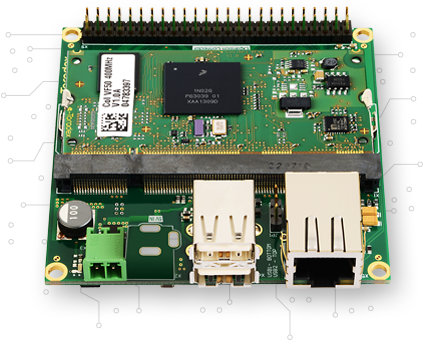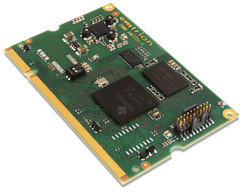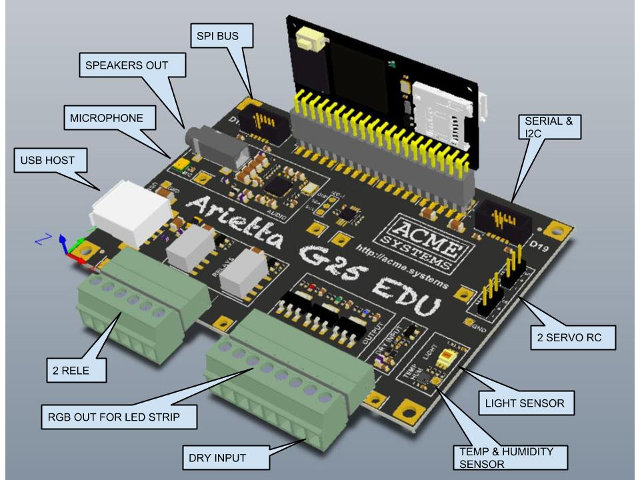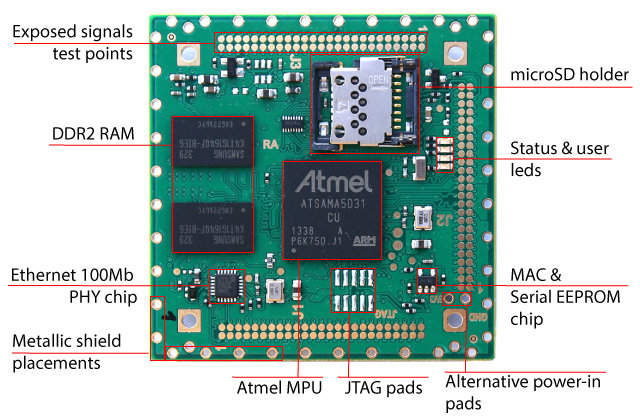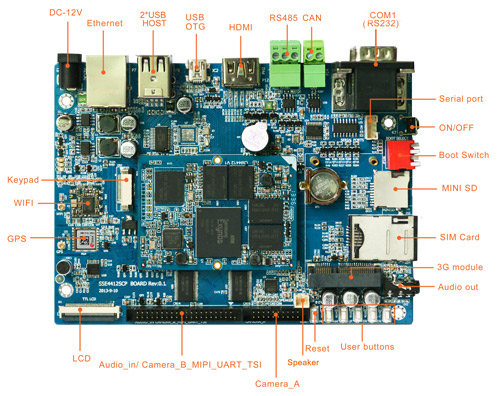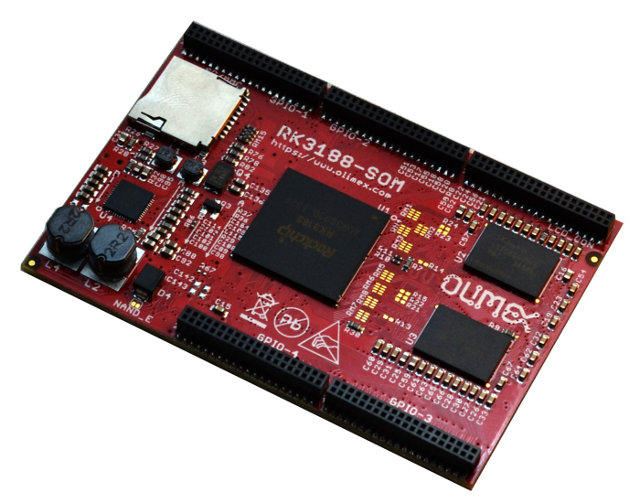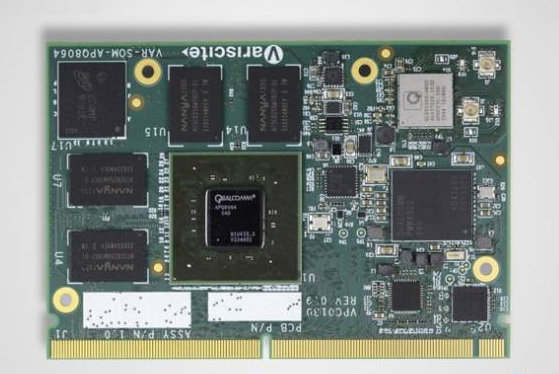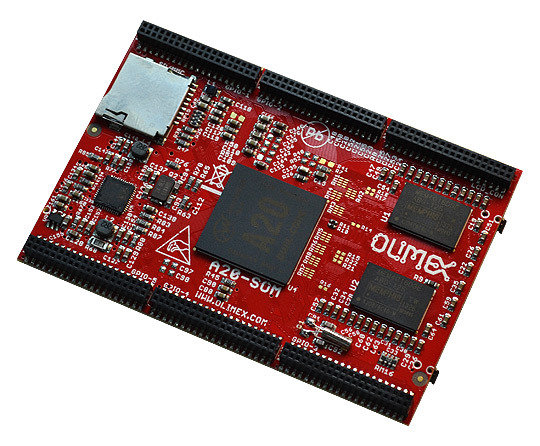Toradex has launched what they call “Customized SBCs” (Single Board Computers) comprised of the usual carrier board an computer-on-module (CoM) combination, using their Apalis & Colibri families. The company offers various combination of Freescale i.MX6 and Vybrid VF50 single board computers, with price starting at 39 Euros for 1k order, or 49 Euros for samples. I’ve already featured Toradex Colibri VF50 (and VF61) modules in another post, but to summarize Colibri VF50 is a computer modules based on Freescale Vybrid VF50 ARM Cortex A5 CPU with 64 to 128MB DDR3, and 128MB NAND flash that targets industrial applications requiring long term availability (15 years). VF50 sells as low as 19 Euros per unit for 10k orders. Viola is a new open source hardware carrier board with the following features: Compatible with all Toradex Colibri CoMs External Storage – microSD interface Video – RGB LCD Interface, 4 wire resistive touch interface […]
Emtrion DIMM-AM335x SoM Supports Mainline Linux Kernel
When I cover system-on-modules (SoM), companies will usually provide some BSP (Board Support Packages) for older kernels, and did not submit their changes to mailine kernel, so I was interested in a news from Emtrion entitled “DIMM-AM335x: Linux mainline support ready“, which actually means they’ve done the work to support a recent Linux kernel (3.14) and provides instructions and code (device tree files), but did not submit patches to the linux-arm-kernel mailing list to get their changes added to kernel.org. Let’s look at the hardware specs first: SoC – Texas Instruments Sitara AM335x ARM Cortex A8 processor @ 720Mhz to 1GHz (AM3354 or AM3359) System Memory – onboard 512 MB SDRAM/optional 256 MB Storage – 512 MB NAND Flash (managed) + 2 SD card interfaces Display – LCDs I/F with resolution up to SVGA, with 4-wire touch interface Audio – Analog Audio with SSI I/F USB – USB 2.0 Host […]
Acme Systems Arietta EDU Open Hardware Baseboard for Arietta G25 SoM (ARM9)
Arietta G25 is a tiny system-on-module (SoM) powered by Atmel SAM9G25 ARM9 processor and running Linux that sold for a discount earlier this year (9.9 Euros) for early backers, and is now available for 20 Euros, and support an optional Wi-Fi module for as low as 7 Euros extra. Acme Systems, the company who made the board, is now considering designing and manufacturing an open source hardware baseboard for the module, and is asking for feedback from the community before going ahead. Currently the idea is to have a baseboard with the following: Arietta G25 SoM connector (Vertical mount) 1x USB Host port I2C Sensors – Temperature and Humidity sensor, Light sensor Mosfet output for RGB led strip 2x relay output 1x filtered dry input 2x servo RC motors output Audio interface with embedded microphone and jack for PC speakers using Wolfson WM8731 codec Expansion headers for external modules already […]
Acme Systems Acqua A5 is a System-on-Module Powered by Atmel SAMA5D3 Processor
Acme Systems has announced availability of their Acqua A5 SoM with Atmel SAMA5D31 Cortex A5 micro-processor, up to 512 MB RAM, up to 256 MB Flash, a serial EEPROM, a micro SD card slot, and an Ethernet PHY. The module targets headless or LCD based system such as automation or control panels, and is available in commercial and extended temperature range. Specifications: Processor – Atmel SAMA5D31 ARM Cortex-A5 MPU @ 536MHz System Memory – 256MByte DDR2 RAM @ 32 bit (optionally 512MB) Storage Embedded micro SD hinge type holder for OS and data Optional 256 MB NAND flash Atmel AT24MAC402 – 2Kbit serial EEPROM Connectivity – 10/100 Mbit Ethernet I/F (can be turned off for power saving) Three USB Host ports (one configurable as USB device) Connectors – 3x 50-pin connectors pitch 1.27 mm (50 mils) Signal accessible via connectors: (Check pinout for details) 10/100 Mbit Ethernet phy RGB I/F […]
Boardcon EM4412 SBC Powered by Exynos 4412 SoC Targets Embedded & Industrial Applications
Boardcon Technology Limited, a Shenzhen based ODM specializing in industrial boards and modules, has announced their EM4412 single board computer featuring MINI4412 core board powered by Samsung Exynos 4412 quad core Cortex A9 SoC a few months ago. The board, with ports such as CAN, RS-485, and a DB9 RS-232 connector, appears to have been designed with industrial applications in mind, such as point-of-sales (PoS), slot machines, car-mounted systems, factory automation, traffic management, and more. Boardcon EM4412 specifications: SoC – Samsung Exynos 4412 quad core Cortex A9 cores @ up to 1.6GHz and ARM Mali-400MP4 GPU System Memory – 2GB DDR3 RAM Storage – 4GB eMMC flash + mini? / micro SD card slot Display HDMI 1.4 – Up to 1080p30 24-bit RGB parallel LCD interface Optional 4.3″, 7″, or 10.1″ch resistive or capacitive touchscreen Camera interfaces: MIPI-CSI slave (mipi2L CH) Optional 2x camera interfaces supporting ITU 601/656 I/F up […]
Olimex Showcases RK3188-SOM Module and RK3188-EVB Evaluation Board
After launching AllWinner and Texas Instruments SoMs earlier this month, Olimex appears to be on a roll, and the company showed some working prototypes of their upcoming Rockchip RK3188 quad core ARM Cortex A9 system-on-module, and corresponding evaluation board called RK3188-SOM-EVB including both a baseboard and a SoM. Preliminary specifications for RK3188-SOM: SoC – Rockchip RK3188 quad core ARM Cortex A9 @ 1.6Ghz with Mali-400 MP4 CPU System memory – 1GB DDR3 Storage – micro SD card slot, and optional 4GB NAND flash Power Management IC Debugging – debug UART console Misc – 2x buttons, 3x status LEDs Connectors – 5 GPIO connectors 2×20 pins 0.05″ step There will be two models: RK3188-SOM and RK3188-SOM-4GB, the latter adding 4GB NAND Flash. Both will be available in June for respectively 40 and 45 Euros per piece for 1k orders. For development and evaluation purpose, the company will also provide an open source hardware base board, RK3188-SOM-EVB, […]
Variscite VAR-SOM-SD600 System-on-Module Features Qualcomm Snapdragon APQ8064 SoC
It turns out Compulab is not the only (Israeli) company to have announced a Qualcomm Snapdradon 600 CoM this month, as Variscite has unveiled VAR-SOM-SD600 system-on-module with Qualcomm APQ8064 quad core SoC, up to 2GB DDR3, up to 64GB eMMC, Wi-Fi and Bluetooth BLE connectivity, and various signals available via a 314-pin MXM 3.0 connector. VAR-SOM-SD600 / VAR-SOM-APQ8064 specifications: SoC – Qualcomm Snapdragon 600 (APQ8064) quad core Krait 300 processor @ 1.7GHz with Adreno 320 GPU and Hexagon QDSP6 DSP System Memory – Up to 2GB DDR3 (Options: 512 MB , 1024 MB) Storage – Up to 64GB on-board eMMC (Options: 4 GB, 8 GB, 16 GB). 2x SD / MMC and SATA 1.5Gbps interface (via connector) Display HDMI 1.3a, up to 1920 x 1080 LVDS, up to 2048 x 1536 24-bit DSI, up to 2048 x 1535 24-bit Audio – Headphone driver, analog/digital microphone, Line In/Out, I2S interface, WCD9311 audio codec. Camera […]
Olimex Introduces Low Cost AllWinner A13, AllWinner A20 and TI Sitara AM3352 Systems-on-Module
About a year ago, Olimex reported working on an AllWinner A20 System-on-Module. But after some unexpected delays, Olimex A20-SOM is finally available, and they’ve even announced A13-SOM and AM3352-SOM, respectively based on AllWinner A13 and Texas Instruments Sitara AM3352 ARM Cortex A8 SoCs, with price starting at 12 Euros for 1K orders. Olimex A20-SOM and A20-SOM-4G There are actuall two versions of the SoM, A20-SOM-4G including 4GB NAND flash, and A20-SOM without. Here are the specifications: SoC – AllWinner A20 dual core ARM Cortex A7 processor with Mali-400MP2 GPU System Memory – 1GB DDR3 memory Storage – 4GB NAND Flash (A20-SOM-4G only) + microSD slot Debugging – UART console connector (at the back) PMIC – AllWinner AXP209 PMU IC Misc – Status LEDs, RESET, RECOVERY buttons Connectors – 6x 2×20 pin 0.05″ female headers Dimensions – N/A The SoM is said to support Android and Debian, but you could also […]


